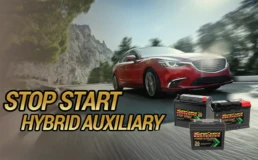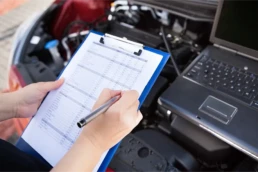
Ultimate Guide to Start Stop Car Batteries
Start stop car battery technology has revolutionized the automotive industry, enhancing fuel efficiency and reducing emissions by automatically shutting down and restarting the engine at traffic stops. This technology relies on specialized batteries known as Stop Start batteries, which are designed to handle the unique demands of frequent start-stop cycles. In this comprehensive guide by Supercharge, we explore everything you need to know about Stop Start car batteries, including their types, benefits, maintenance, and frequently asked questions.
Looking for information on regular car batteries? Check out our Supercharge Car Battery Superguide here.
Start Stop Car Batteries Explained
start stop cars require batteries that can handle frequent charging and discharging cycles without compromising performance or longevity. Traditional lead-acid batteries struggle to meet these demands effectively.
Therefore, two main types of batteries are commonly used:
- Enhanced Flooded Batteries (EFB): EFB batteries are an evolution of standard lead-acid batteries, featuring enhanced durability and cyclic capabilities. They are cost-effective solutions for vehicles with moderate Stop Start requirements.
- Absorbent Glass Mat (AGM) Batteries: AGM batteries offer superior performance and durability compared to EFB batteries. They are designed with advanced technology, using absorbent glass mat separators to enhance cyclic stability and resistance to vibration.
Choosing A Start Stop Car Battery
When choosing a battery for your vehicle, nothing beats the reliability and longevity of a SuperCharge start stop battery. With over a century of experience, our parent company RAMCAR manufactures these batteries in state-of-the-art facilities, ensuring they exceed industry standards and original equipment requirements. As the preferred supplier for major automotive corporations, our commitment to innovation charges through in every battery we produce. Designed with meticulously selected components and advanced technology, our batteries deliver unparalleled efficiency, prolonged service life, and robust performance. Engineered to withstand the rigorous demands of stop-start engines, including frequent discharges and in-cabin installations, our batteries feature hardened framed plates, corrosion-resistant alloys, and a vibration-resistant design. When you choose SuperCharge Start Stop batteries, you’re investing in reliability, durability, and peace of mind on every journey.
Start Stop Battery Maintenance
Maintaining a start stop battery is crucial for ensuring its longevity and optimal performance, especially given the demanding nature of start stop technology. Here’s a comprehensive 10-step guide to effectively maintain your start stop battery:
- Understand Your Battery: Familiarize yourself with your specific start stopbattery’s requirements and specifications, which can usually be found in the owner’s manual or manufacturer’s guidelines. Use our battery finder to assist matching a SuperCharge start stop battery to your car.
- Regular Visual Inspections: Conduct visual inspections of the battery and its surroundings. Look for signs of corrosion, leaks, or physical damage. Address any issues promptly to prevent further damage.
- Check Voltage Levels: Use a multimeter to measure the battery’s voltage regularly. A healthy battery should typically show around 12.6 to 12.8 volts when fully charged. Anything significantly lower may indicate a problem.
- Clean Terminals: Over time, terminals can accumulate corrosion, which hampers electrical conductivity. Clean the battery terminals and cable connections using a mixture of baking soda and water or a dedicated battery terminal cleaner. Ensure terminals are dry before reconnecting cables.
- Inspect Cables and Connections: Inspect battery cables for any signs of wear, corrosion, or loose connections. Tighten connections as needed and replace cables that show signs of damage.
- Maintain Proper Charging: Ensure the battery is charged properly to maintain its health. If your vehicle doesn’t have a built-in maintenance charging system, consider using a battery maintainer or charger designed for AGM or EFB batteries.
- Drive Regularly: start stop batteries benefit from regular use. If your vehicle is not used often, consider taking it for occasional drives to prevent the battery from draining excessively.
- Avoid Deep Discharges: Minimize deep discharges, which can shorten battery life. If your vehicle experiences frequent battery drains, consider checking for underlying electrical issues that may be causing excessive drain.
- Protect from Extreme Temperatures: Extreme heat or cold can affect battery performance and lifespan. Park your vehicle in a garage or shaded area whenever possible to mitigate temperature extremes.
- Follow Manufacturer Guidelines: Always follow the maintenance guidelines provided by the battery manufacturer and your vehicle’s manufacturer. This includes recommended intervals for battery checks, replacements, and any specific care instructions.
By following these steps diligently, you can maximize the lifespan and performance of your start stop battery, ensuring reliable operation of your vehicle’s electrical systems and start-stop functionality. Regular maintenance not only extends battery life but also enhances overall vehicle reliability and efficiency.
Avoiding Deep Discharges on a Start Stop Car
A “start stop battery deep discharge” refers to the situation where a stop-start battery, which is designed for vehicles equipped with start-stop technology, undergoes a discharge that significantly reduces its state of charge (SOC).
In vehicles with start-stop systems, the battery experiences frequent cycles of discharging and recharging as the engine automatically shuts off when the vehicle comes to a stop and restarts when the driver lifts off the brake pedal. These cycles can lead to what is known as shallow cycling, where the battery is not fully discharged before being recharged.
However, a deep discharge occurs when the battery is subjected to a discharge that goes beyond the typical shallow cycling. This could happen if the vehicle is left with accessories running while the engine is off for an extended period, or if there’s a fault in the electrical system causing excessive battery drain.
Deep discharges can negatively impact the performance and lifespan of a stop-start battery. These batteries are designed to handle frequent shallow cycles but may degrade faster if subjected to deep discharges regularly. It can lead to reduced capacity, increased internal resistance, and ultimately shorten the battery’s useful life.
To prevent deep discharges, it’s important to ensure proper maintenance of the vehicle’s electrical system, avoid unnecessary drain on the battery when the engine is off, and follow manufacturer recommendations for battery care and maintenance. Regularly checking the battery’s state of charge and voltage levels can help identify any issues early and prevent deep discharges that could affect battery performance.
How to install a Start Stop Car Battery
Installing a start stop car battery is a straightforward process that can be done with basic tools and following proper safety precautions.
Here are 10 steps to guide you through the installation:
- Gather Tools and Materials: Ensure you have the necessary tools, including wrenches or sockets (usually 10mm or 13mm), gloves, and safety goggles. Also, have the new battery ready.
- Park the Vehicle Safely: Park the vehicle on a flat surface and engage the parking brake. Turn off the engine and remove the keys from the ignition.
- Locate the Battery: Open the hood and locate the existing battery. It’s typically located in the engine bay, either on the side or near the front of the vehicle.
- Disconnect the Negative Terminal: Using a wrench or socket, loosen the nut on the negative (-) terminal clamp. Remove the clamp from the battery terminal and secure it away from the battery to prevent accidental contact.
- Disconnect the Positive Terminal: Repeat the process for the positive (+) terminal. Loosen the nut on the positive terminal clamp, remove the clamp from the battery terminal, and set it aside.
- Remove the Old Battery: Depending on the type of battery mount, there may be a bracket or strap securing the battery in place. Use appropriate tools to loosen and remove any securing mechanisms. Carefully lift the old battery out of the battery tray and place it aside.
- Prepare the New Battery: Ensure the new start stop battery is the correct size and type for your vehicle. Check the terminals to confirm they match the old battery (top post or side post). If necessary, transfer any protective caps or covers from the old battery to the new one.
- Install the New Battery: Carefully place the new battery into the battery tray, ensuring it sits securely. Replace any brackets or straps and tighten them securely to hold the battery in place.
- Connect the Positive Terminal: Slide the positive terminal clamp over the positive battery terminal. Tighten the nut securely using a wrench or socket.
- Connect the Negative Terminal: Slide the negative terminal clamp over the negative battery terminal. Tighten the nut securely using a wrench or socket.
- Check Installation: Ensure all connections are tight and secure. Double-check that the positive and negative terminals are correctly connected. Inspect the battery for any signs of damage or leaks.
- Test the Battery: Start the vehicle to ensure the new battery is functioning properly. Check that all electrical systems, including lights and accessories, are working correctly.
Please note, it is always recommended to replace your battery with the same OE specifications and technology. If you are changing battery technology, your vehicle would need reprogramming as the charging system would have changed.
By following these steps carefully, you can successfully install a start stop car battery and ensure reliable performance from your vehicle’s electrical system. If you’re unsure about any step, refer to your vehicle’s owner’s manual or consult a professional mechanic for assistance.
Find a Supercharge Start Stop car battery near you
Once you’ve selected the perfect battery for your vehicle from Supercharge’s extensive range, finding your nearest reseller is quick and easy with our “Find a Dealer” map. Enter your location details to discover a network of authorized Supercharge dealers conveniently located near you. Whether you’re in need of professional installation services, expert advice, or simply want to purchase your chosen battery in person, our trusted dealers are ready to assist you.
With a commitment to customer satisfaction and excellence in service, Supercharge dealers ensure a seamless and hassle-free experience so you can get back on the road with confidence. Visit our website today to find your nearest Supercharge dealer and experience the convenience of shopping for your automotive battery needs.
Commonly Asked Start Stop Car Battery Questions
Start Stop batteries need a bit more consideration than your average battery, so check out common stop start battery questions we get from our customers.
Yes, Start Stop batteries are specifically designed to withstand the demands of frequent engine restarts and provide reliable power for electrical systems during engine off periods.
Start Stop batteries generally cost more than traditional batteries due to their advanced technology and enhanced durability.
Yes, you can replace a Start Stop battery yourself following manufacturer guidelines and safety precautions. However, due to the sensitive electronics involved, it’s advisable to consult your vehicle’s manual or a professional if unsure.
Yes, you can use a Start Stop battery in a normal car. However, it may not provide significant benefits unless the vehicle operates under similar stop-start conditions.
Yes, start stop batteries can be charged using appropriate battery chargers designed for AGM or EFB batteries.
Yes, you can jump start a Start Stop battery following standard jump-starting procedures. However, ensure both vehicles are compatible and follow safety guidelines.
Using a non-start stop battery in a start stop vehicle may lead to reduced performance and lifespan, as these batteries are not designed for the cyclic demands of Stop Start systems.
If your vehicle is equipped with start stop technology, using a dedicated start stop battery is recommended to ensure optimal performance and longevity of the battery and electrical system.
Start stop batteries typically do not require programming. However, some vehicles may require a battery reset or registration process using diagnostic tools after battery replacement.
Frequent start-stop cycles can accelerate battery wear. However, properly designed AGM or EFB batteries mitigate this issue with robust construction and cyclic durability.
The lifespan of Start Stop batteries varies depending on usage, maintenance, and environmental factors. Generally, AGM batteries can last longer than EFB batteries due to their superior construction.
Start stop batteries cost more than traditional batteries, with prices varying based on battery type, brand, and specifications. Expect to pay a premium for AGM batteries compared to EFB.
Changing a start stop battery involves disconnecting the old battery, removing it from the vehicle, installing the new battery, and reconnecting it following manufacturer guidelines.
You can test a start stop battery using a battery tester or multimeter to measure voltage and conductance. Professional technicians can also perform load testing to assess battery health.
Using an AGM charger to charge an EFB battery is generally safe, as long as the charger voltage and charging profiles are compatible with the battery specifications.
EFB and AGM batteries serve different purposes and may not be directly interchangeable without considering specific vehicle requirements and manufacturer recommendations.
Replacing an EFB battery with an AGM battery may improve performance and longevity, provided the AGM battery meets the vehicle’s electrical and physical requirements.
You’re a Start Stop Car Battery Professional Now!
Choosing the right start stop battery for your vehicle is crucial for optimal performance and longevity. Whether opting for an EFB or AGM battery, Supercharge can offer a premium battery product back with years of research and a great warranty.



